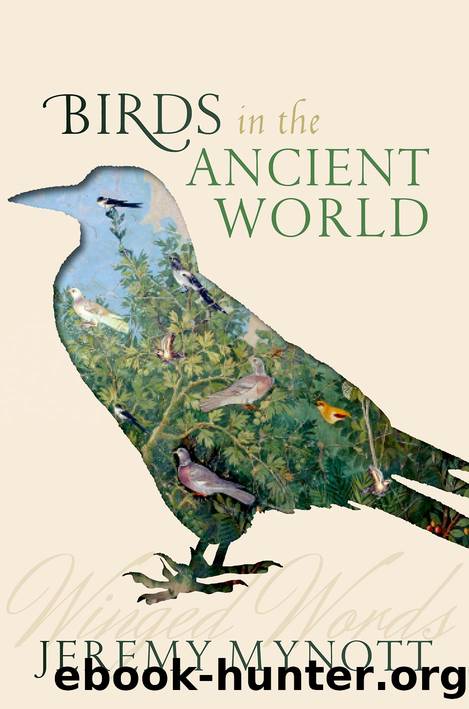Birds in the Ancient World by Jeremy Mynott

Author:Jeremy Mynott [Mynott, Jeremy]
Language: eng
Format: epub, azw3
ISBN: 9780191022722
Publisher: OUP Oxford
Published: 2018-03-21T00:00:00+00:00
1 Perhaps he is thinking of crocodiles here.
1 Anaximander (died c.545 bc) is the first from this group definitely attested to have produced a book of some sort (and also a map).* Books, in the sense of written, non-fiction texts, were at a very early stage of evolution in what was still a largely pre-literate society; they could also take forms that may seem surprising now—those by Xenophanes and Empedocles, for example, were in verse not prose.
1 Some other works were definitely not by him at all and these are indicated in the notes and references by putting his name in square brackets, as in [Aristotle], Mirabilia.
2 For example, his discovery of the remarkable reproductive structures of the common smooth-hound Mustelus mustelus (a small species of shark), which were ‘rediscovered’ and confirmed by Johannes Müller in 1842.*
1 Aristotle’s usual terms are eidos (‘species’), genos (‘genus’), and megiston genos (‘main kind’).* The standard modern taxonomic sequence for a rook, however, would run: Kingdom (Animalia: Animals), Phylum (Chordata: With backbones), Class (Aves: Birds), Order (Passeriformes: Perching birds), Family (Corvidae: Corvids), Genus (Corvus: Crows), and Species (Corvus frugilegus: Rook).
1 Probably about 140 species of birds are distinguished in the whole corpus, depending somewhat on how you count groups of birds and obscure cases.* See also the appendix, pp. 363–67, for some general remarks about naming and identification.
1 I have used these older terms because, although the identity of the barred (lesser spotted) woodpecker (Dendrocopos minor) seems clear from the reference to its size, the pied one was probably the middle spotted (D. medius, common in Lesbos) rather than the great spotted (D. major, the familiar one in Britain).
2 This bird sounds like a treecreeper (but see pp. 234–35).
3 Literally the ‘ravine bird’, probably a stone curlew Burhinus oedicnemus from this description.
4 Probably, from this and other references, a white wagtail Motacilla alba. Aristotle refers earlier (HA 593b4–7) to this tail-wagging, which gave rise to a verb describing vigorous sexual thrusting.*
1 This is probably the yellow wagtail Motacilla flava, which elsewhere is said to forage in agitated fashion around livestock, as indeed it still does (HA 609b15–20).
1 The hairs over the eyes are not actually eyelashes and each foot has two large toes (which look like but are not actually hooves).
2 A loaded expression, to be sure, but Darwin himself says that ‘species’ is a term ‘arbitrarily given for the sake of convenience’ (1859), ch. 2.
3 Three kinds of swifts and five of hirundines occur locally.
4 This etymology survives in the current scientific name of the swift genus, Apus.
1 Darwin complains about some of Aristotle’s ‘grossest mistakes’ in a less often quoted passage from the highly complimentary letter cited above (p. 227).
1 The physicist Fred Hoyle stoutly maintained to the last that all the world’s viruses and bacteria came to us from outer space.
2 Darwin borrowed the Latin tag ‘Natura non fecit saltus’ (‘Nature does not make jumps’) from Linnaeus and he uses it no fewer than seven times in The Origin of Species, though it has since become a controversial claim.
Download
This site does not store any files on its server. We only index and link to content provided by other sites. Please contact the content providers to delete copyright contents if any and email us, we'll remove relevant links or contents immediately.
| Amphibians | Animal Behavior & Communication |
| Animal Psychology | Ichthyology |
| Invertebrates | Mammals |
| Ornithology | Primatology |
| Reptiles |
Sapiens: A Brief History of Humankind by Yuval Noah Harari(13062)
The Tidewater Tales by John Barth(12031)
Do No Harm Stories of Life, Death and Brain Surgery by Henry Marsh(6339)
Mastermind: How to Think Like Sherlock Holmes by Maria Konnikova(6239)
The Thirst by Nesbo Jo(5788)
Why We Sleep: Unlocking the Power of Sleep and Dreams by Matthew Walker(5648)
Sapiens by Yuval Noah Harari(4542)
Life 3.0: Being Human in the Age of Artificial Intelligence by Tegmark Max(4512)
The Longevity Diet by Valter Longo(4447)
The Rules Do Not Apply by Ariel Levy(3908)
The Immortal Life of Henrietta Lacks by Rebecca Skloot(3828)
The Body: A Guide for Occupants by Bill Bryson(3804)
Why We Sleep by Matthew Walker(3775)
Animal Frequency by Melissa Alvarez(3755)
Yoga Anatomy by Kaminoff Leslie(3705)
Barron's AP Biology by Goldberg M.S. Deborah T(3633)
The Hacking of the American Mind by Robert H. Lustig(3581)
All Creatures Great and Small by James Herriot(3519)
Yoga Anatomy by Leslie Kaminoff & Amy Matthews(3397)
